Death of the 20 Russian Corps
To implement the plan for preparing a simultaneous offensive against both East Prussia and Austria-Hungary, the Russian North-Western Front began the preparation of an offensive operation. The seizure of East Prussia was to be carried out by the armies of the right wing of the front - the 10-I army of Thaddeus Sivers and the newly formed 12-I army of Paul Plehve. The armies of the front left wing (1, 2, and 5), located on the west bank of the Vistula, were given the task of holding their positions behind Bzura and Ravka, and after their manning they also had to go on a general offensive.
The main role in the operation was to be played by the army of Sivers, which was located from the Neman River and further south along the line of the Mazury lakes. The Verzhbolov group was located on the right flank of the army - four separate detachments (about 3-x cavalry divisions) and 3-corps under the general command of the corps commander Yepanchin. In the center of the military formations of the army in the area of the Mazury lakes were Bulgakov's 20 corps and Herngross's 26 corps. On the left wing, from Lettsen to the south to the state border, the 3 of the Siberian corps of Radkevich was stationed. In general, the army consisted of 11,5 infantry and 2,5 cavalry divisions (about 155 thousand soldiers and officers). The army was built in line, which excluded the possibility of maneuvering forces. The beginning of the offensive was scheduled for 10 (23) in February of 1915. It was believed that by this date the 10 and 12 armies would be ready for the offensive.
The German command also did not sit with folded arms and was preparing for an offensive. In January 1915, four new corps were deployed to the Eastern Front. Of these, three (38, 39 and 21 army corps) were used to form the 10 army, one aimed at strengthening the 8 army. The first command of the German command was to carry out the 8 (over 7 infantry and 1 cavalry divisions) and 10 (over 7 infantry and 1 cavalry divisions) armies against the 10 Russian army. Total German forces consisted of 8,5 army corps, about 250 thousand people.
The German army von Eichhorn’s 10 Army spun from Tilsit to Insterburg. To the south, Otto von Belov's 8 Army was located. It part of the forces (1-i and 10-i landvernye and 3-i reserve divisions, garrison Lettsen) defended the line of Masuria Lakes and had on its right flank between the lake Spierding (Spearding) and the state border the strike team Littsman (40-i reserve corps Litzman, 2-I Infantry Division, 5-I Infantry and 3-I Cavalry Brigade with some Landwehr). In the area of Soldau, the army group Galvitsa was formed, which was to provide the rear of the 10 and 8 armies from the possible attack of the Russian troops from the south.
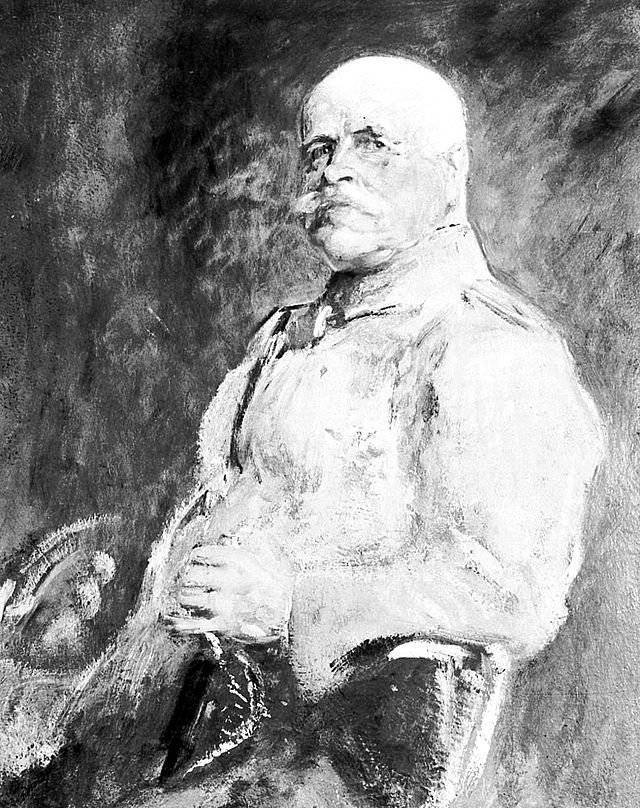
German Army 10 Commander Hermann von Eichhorn
The idea of the German command was set forth in two Hindenburg directives from January 15 (28) and January 26 (February 8). The 10 Army was to strike at Tilsit Wilkovishki, covering the northern flank of the Russian army; The Königsberg Landwerk Division of the 10 Army and the left flank of the 8 Army were to bind the Russian troops in battle at the front; the right flank of the 8 Army to attack Aris, Johannisburg and to the south. The second directive set the offensive time: for 8 Army - January 25 (February 7), and January 10 (February 26) for the 8 Army. In addition, the troops of the 10 Army received the task of making a deeper coverage of the Russian troops. The 10 Army and the Litzman Group of the 8 Army, encompassing the extreme flanks of the Russian army, were supposed to close the encirclement in the Augustow area.
Battle
Sivers, due to poor organization of intelligence, did not have information about the appearance of the new 10 of the German army in his sector, which they aimed at striking the right flank of his army. However, the command of 10 of the Russian army understood the danger of the linear position of the troops and worked out options for withdrawing troops to the rear positions.
The command of the North-Western Front, preparing for an offensive operation, decided to improve the position of the right flank of the 10 Army. To this end, small cavalry forces, which were gradually strengthened by infantry and artillery, attacked the enemy in the forest area near Lasdenen. But the German troops stubbornly held the area, covering the deployment of the corps 10 th army. Push back the enemy failed. These fights, which lasted from 12 (25) in January to 25 in January (7 in February), are sometimes called the Lasdena operation. These were typical fights of a local character, with the aim of improving the location of the right flank of the army.
The Germans could not be defeated due to the underestimation of their strength. The Russian command assumed that in the area of Lasdenan are minor landshturmenny units (militia), with a small amount of artillery. In fact, it turned out that the Russian forces were opposed by significant forces of the German regular forces. The operations showed that the German command was persistently striving to keep the area in its hands and revealed the emergence of new German units. However, the Russian command did not attach much importance to this fact. As a result, the emergence and concentration of the German army 10 passed unnoticed by the Russians, which predetermined the defeat of the Russian army.
On January 25 (February 7), the shock group of the 8 Army led by Litzman launched an offensive. 26 January, the Germans occupied Johannisburg, and continued the offensive, bypassing Lyk from the south. The right column of the Litzman group - the 3 Cavalry Brigade, constantly reinforced by other parts of the 8 Army, advanced on Raygorod, defending the flank of the army from Osovets. In the center of the German troops, as expected by the plan of the Hindenburg, acted passively.
January 26 (February 8) launched the Eichhorn 10 Army. The right flank of the Russian army - Verzhbolovskaya group, under the onslaught of superior enemy forces was forced to retreat. The situation is dangerous. German troops began to move quickly to the rear of the main forces of the Sivers army. Meanwhile, on the left flank, the situation improved somewhat. The left-flank 3 of the Siberian Corps successfully repulsed the attacks of the shock group of the 8 Army and stopped the enemy on the line Lyk - Raygorod. However, the Russian command, fearing encirclement, issued an order for a general retreat to the Kovno-Osovets line. Army warehouses destroyed. Crackers, sugar, canned food were handed out to the soldiers, who would take much, the rest was burned.
Repulsing the attacks of superior enemy forces, the 20, 26 and 3 Siberian corps retreated to the line of the Neman and Beaver rivers. The Germans tried to take them into the ring of the environment. They tried to repeat the defeat of Samsonov's 2 Army in 1914 year. Disorganize Russian troops, break their pressure, cause panic and persuade to surrender. However, the Russian troops were already well-fired, the commanders guided skillfully, the soldiers were not afraid of the Prussians, met them with bullets and bayonets. Towards the Russian corps struck a garrison of the fortress of Grodno. As a result, the two corps threw back the still weak parts of the enemy and left the closing ring.
Especially intense battles after the departure of the 3 Corps to Kovno had to lead the 20 Corps under the command of Pavel Bulgakov. Russian troops had to simultaneously deter frontal attacks of the 8 Army and attacks of the bypassing troops of the 10 Army. The corps troops were very tired, retreating for several days without rest and hot food, while at the same time leading battles with the enemy. 2 (15) February Corps went out into the August forests. Here, the 20 Corps (4 divisions) had to go into battle with seven infantry and two cavalry divisions of the enemy. 3 (16) February The 27 Russian Infantry Division defeated the 42 Infantry Division, taking more than 1 Thousands of people prisoners and 13 guns. However, the situation was critical. German troops surrounded the Russian corps near the city of Lipsk. About 40 thousand Russian soldiers got into the dense ring of the environment.
For five days, four Russian divisions — the 27, 28, 29, and 53 infantry divisions — fought an unequal battle with the German troops. The hungry Russian soldiers who had not slept for several nights in a row showed tremendous courage and perseverance, over and over again trying to break through the ring of encirclement. Thousands of soldiers fell in the snowy forests, trying to break through to their own. As the war correspondent of the German weekly newspaper Rolf Brandt wrote: “The honor of the 20th corps was saved ... The attempt to break through was utterly insane, but holy insanity is a heroism that showed the Russian soldier in his full light, whom we have known since the time of Skobelev, since Plevna , battles in the Caucasus and the storming of Warsaw! A Russian soldier knows how to fight very well, he suffers any hardships and is able to be persistent, even if certain death is inevitable! ”
Separate parts of the corps (113 and 114 regiments) could make their way to the Grodno fortress. The main forces of Bulgakov’s corps, after shooting the entire ammunition to 8 (21) in February, and having destroyed the guns so that they did not fall into the hands of the enemy, in bloody bayonet attacks they tried to pave the way to their own. In the brutal battles of the morning of 9 (22) in February, the last forces of the 20 corps were exhausted.
The 8 (21) of February, retreated to the Grodno and the line of the Beaver River, the 10 units of the Russian army, replenished reinforcements, launched a counter-offensive in order to help out their comrades, but the counter-strike was late. The remnants of the corps were forced to surrender. General Bulgakov, together with the corps headquarters, was captured in Germany. In addition, the Germans, in addition to the inner ring of the environment, equipped the outer one and created well-fortified positions.
However, the heroic resistance of the 20 corps, which held the main forces of the 8 and 10 armies for several days, distracted the German command from the realization of the main objective of the operation. German troops won a tactical victory over the 10 corps, but they could not fulfill the plan for the environment of the 10. Thanks to the courageous resistance of the Russian soldiers and commanders, parts of the three other corps of the 10 Russian army managed to avoid encirclement, regroup their forces, and by the end of February 1915 could gain a foothold at the new line of defense along the Kovno-Osovets line. The path to the enemy in the southeast direction was blocked. The North-Western Front survived and was later able to restore some of the lost positions.
Not only the soldiers of the 20 corps, but also the defenders of the Osovetskoy fortress showed great resistance in this battle. This fortress was located on the left bank of the River Beaver and covered the 50-kilometer gap between the flanks of the 10 and 12 of the Russian armies, and also protected the important railway junction Bialystok. Osovetsky fortress defended a garrison of approximately one division and 93 fortress and field guns. Commanded the garrison, Major General Nikolai Brzozovsky. During the August operation, the Osovets garrison isolated a squad of infantry with artillery and sent it to Grajewo, threatening the right flank of the 8 of the German army. The detachment’s actions distracted German troops and eased the position of the left-flank corps of the 10 Army near Raigorod. After that, the Germans organized the second storming of the fortress (the first was in September 1914).
The second assault was organized much more skillfully than the first, when the Germans suffered heavy losses from the fire of the fortress artillery. First, for several days there was a stubborn battle for the front line of field fortifications. New positions, taking into account the battle during the first assault, erected 8-10 kilometers from the fortress to push the fortified line beyond the reach of the enemy’s artillery, but their equipment was not completed. German artillery "plowed" the front edge, but the defenders retreated to the rear positions. When the German infantry went to take positions, they were covered by Russian artillery and, the predpole was well shot, and the Russian infantry counterattacked from the deep lines. Germans fought off.
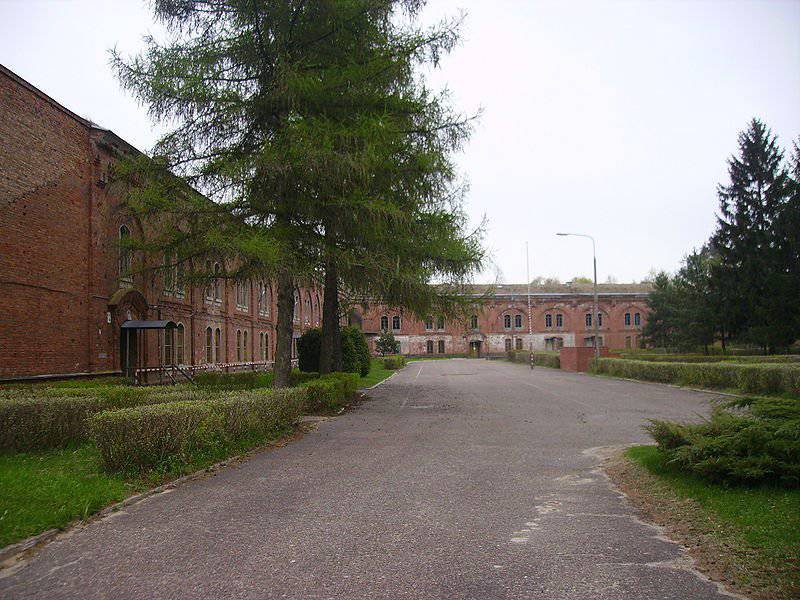
Fortress Osovets. Fort No. 1
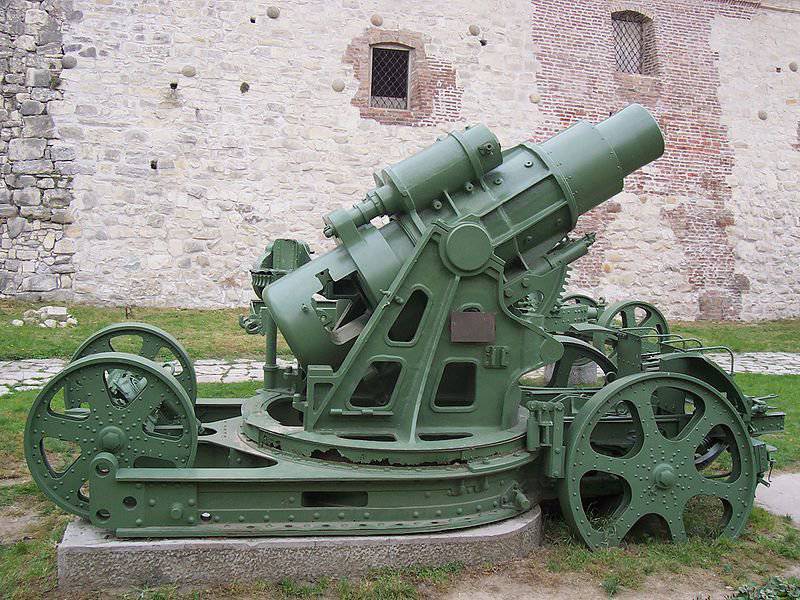
305 mm Mortar Skoda, 1911 g.
However, under the onslaught of superior enemy forces, by decision of the command of the garrison, the troops led off to the second line of field fortifications. This allowed the Germans to begin shelling the fortress from heavy guns of caliber 100 — 420 mm. Especially for the assault on Osovets, the German command transferred to the 4 fortress siege "Skoda" mortars of the caliber 305 mm, and the German 420-mm mortars "Big Bertha". In addition, Osovetsky fortress was bombed by German airplanes. As the European newspapers wrote then, the view of the fortress was terrible: “... the whole fortress was shrouded in smoke, through which, in one place or another, huge fiery tongues burst from the explosion of projectiles; pillars of earth, water, and whole trees flew upward; the earth shook, and it seemed that nothing could withstand such a hurricane of fire. The impression was such that not a single person would leave the whole of this hurricane of fire and iron. ” The most powerful shelling was organized by 14 - February 16 and February 25 - March 5 1915. Thousands of shells fell daily on the Russian garrison. The Russians actively responded and put down several enemy batteries.
The Russian command, believing that it was asking for the impossible, asked the garrison commander to hold out at least 48 hours. However, Osovets defended before mid-August, when the remnants of the garrison left the fortress on the orders of the command, which carried out a general strategic retreat of the Russian army from Galicia and Poland. The German siege corps was hopelessly stuck under the Russian fortress. Although the original plan, the Germans, who easily took such powerful strongholds as Liege, Namur and Maubezh, planned to quickly take Osovetskaya fortress.
In the course of the August operation, the Russian command took a number of important measures to strengthen the situation in the north-western strategic direction. The 15 Corps was redeployed from Gomel to Grodno, which strengthened the front of the 10 Army. The 4 Caucasian Corps was sent to the Orana region from the 3 Army. To Bialystok from the left bank of the Vistula began to transfer 2-th corps. The 1 Army was regrouped on the right bank of the Vistula. Accelerated concentration on the Lower Narew 12 Army. As a result, the onslaught of the German armies was stopped. They were exhausted and lost the opportunity to continue the offensive. At this August operation was completed.
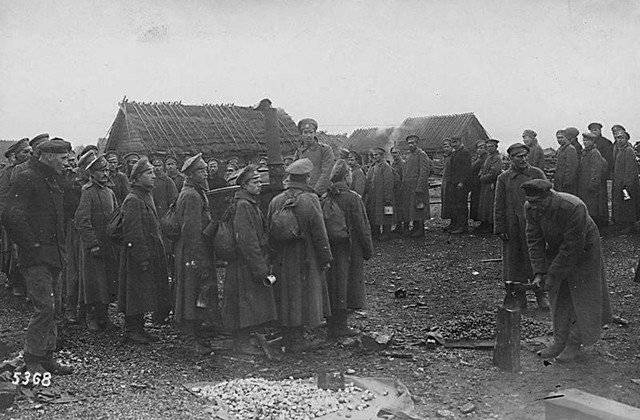
Russian prisoners

Commander of the 20 Army Corps Pavel Ilich Bulgakov
Results of the operation
The plans of the Russian command to invade East Prussia were destroyed. Among the reasons for the defeat of the 10 of the Russian army was the poor intelligence work and the lack of projectiles. The artillery had simply nothing to shoot to support the infantry. Warehouses were empty, and the industry could provide only about a third of the needs of the Russian army. Even worse things were with heavy artillery.
It is also worth noting the mistakes of the Russian command. Sivers and Ruzsky missed the appearance of the whole German army. Although signs of her appearance were. Already in the battles near Lasdenen, the emergence of new Germanic units was noted. And the operation itself could end in the heavy defeat of the German troops, if Sievers and Ruzsky had managed to maneuver in time and struck a counterstrike in the flank of the enemy who had broken through.
Russian troops suffered serious losses - 56 thousand killed, wounded and taken prisoner. German losses were significantly lower - more than 16 thousand killed, wounded and prisoners. Apparently, as was usual, the Germans underestimated their losses.
In Germany itself they organized a propaganda campaign, shouting about “the second Tannenberg, about“ 100 thousand Russian prisoners ”. However, in fact, about 22 thousand people were taken prisoner. Having won a local victory, the Germans failed a strategic operation.
In general, the Eastern Front command plan, which was part of the plan to create the “strategic Cannes” of the Austro-German High Command, failed. The German command planned to carry out a deep coverage of the right wing of the Russian front and, in cooperation with the Carpathian group, to carry out a common strategic environment for the Russian armies. However, in reality, at the cost of serious losses, it was only possible to push back the main forces of the 10 of the Russian army to the Neman and beyond the Beaver River. Sivers army was not defeated, retaining combat capability.
The Germans could only surround one Russian corps. Four fresh German corps were used inexpediently, having spent several days fighting one Russian corps. The surprise factor has been completely lost. The Russian command quickly responded and stabilized the situation. The Germans were able to capture only the forces of the 1 — 1,5 divisions. Could not the German troops and capture the fortress Osovets. Her defense, led by the commandant, General Brzhozovsky, and supported by the actions of the neighboring field troops, steadfastly withstood all German attacks and heavy artillery strikes.
Already February 17 (March 2) The 1-I, 12-I and 10-I Russian armies launched a general offensive. The Russian command responded to the blow of the enemy with a counterstrike. The Prasnysh operation began.
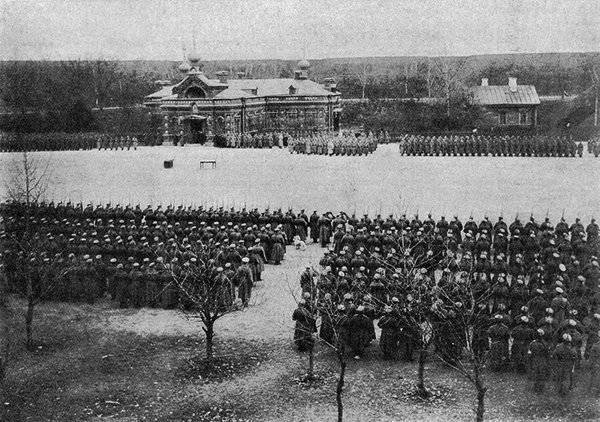
Russian soldiers in Osovets
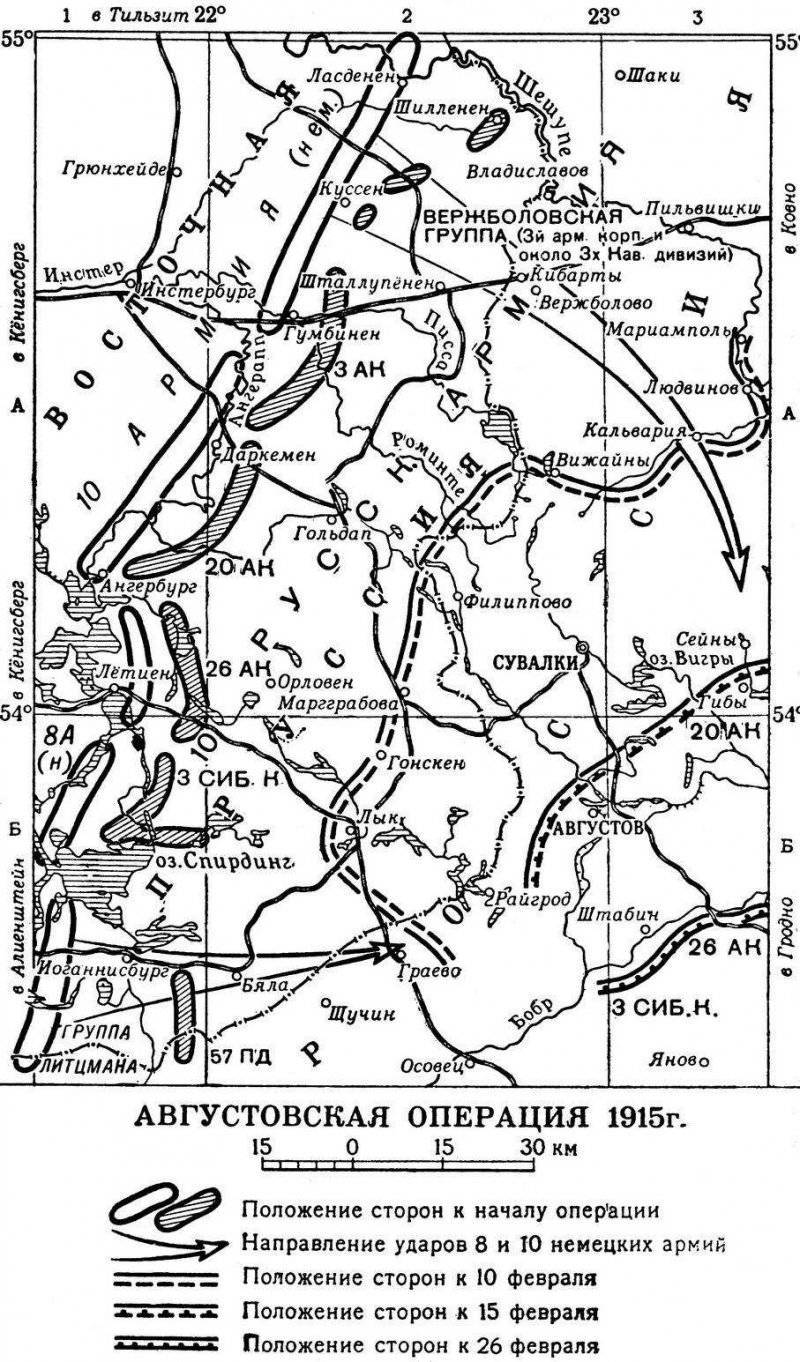
Information